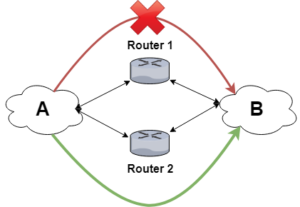Router redundany using HSRP (CISCO)
PROBLEM: I would like would like to use the second router/switch as a backup one.
SOLUTION: Use very simple HSRP!
[?] What is EIGRP?
https://www.cisco.com/c/en/us/support/docs/ip/enhanced-interior-gateway-routing-protocol-eigrp/16406-eigrp-toc.html
Let’s have a look at the topology diagram, at first: We can see two networks (A, B) and two Routers (1, 2). We would like to keep one router as a primary (e.g. Router 1) and the second one as a backup. So e.g. if Router 1 goes down, we can still access the other network through Router 2. Very simple, isn’t it?


Now, let’s move to the configuration part. We have a small network, with two LANs with PCs, one router with a DHCP server (R3) and two nodes (R1 & R2) in the middle. R1 and R2 are redundant and we will configure HSRP on them. But let’s start with routing, at first.
We have to use some dynamic routing here. I chose EIGRP, just because I like it. You can use RIP, OSPF or other. Configuration is very easy, just apply this config to all routers.
Number 10 (router eigrp 10) means the number of AS (Autonomous System), which is a system where devices are under signle technical administration. After this paste all network inside this AS you would like to route between. And that’s it – we have routing set.
|
1 2 3 4 5 |
Router(config)# router eigrp 10 Router(config-router)# network 192.168.1.0 Router(config-router)# network 172.16.0.0 Router(config-router)# network 172.16.1.0 Router(config-router)# network 10.0.0.0 |
Now, we will configure HSRP on R1 and R2. HSRP uses virtual IP and virtual MAC and this IP should be used as a default gateway for all devices connected to this network. Configuration is very simple. 192.168.1.10 will be our virtual IP.
|
1 2 |
R1(config)# interface fastEthernet0/0 R1(config-if)# standby 1 ip 192.168.1.10 |
Do the same on the second router as well.
|
1 2 |
R2(config)# interface fastEthernet0/0 R2(config-if)# standby 1 ip 192.168.1.10 |
We should set up a priority and one more thing to make it working smoothly. Priority has a range 1 – 255 (higher number = higher priority), so using it we will define primary router. Default priority (if not set) is 100. Preempt will ensure switching back to our primary router once it will be back online.
|
1 2 3 4 5 |
R1(config-if)# standby 1 priority 150 //PRIMARY router R1(config-if)# standby 1 preempt R2(config-if)# standby 1 priority 120 //BACKUP router R2(config-if)# standby 1 preempt |
Now we should see HSRP state update on both routers and we can test how it works.
OUTPUT
|
1 2 3 4 5 6 7 8 9 10 11 |
R1#sh standby br P indicates configured to preempt. | Interface Grp Pri P State Active Standby Virtual IP Fa0/0 1 150 P Active local unknown 192.168.1.10 R2#sh standby br P indicates configured to preempt. | Interface Grp Pri P State Active Standby Virtual IP Fa0/0 1 120 P Active local 192.168.1.1 192.168.1.10 |
Trace from PC-1 (192.168.1.100) to PC-3 (10.0.0.11)
|
1 2 3 4 5 |
PC-1> trace 10.0.0.11 trace to 10.0.0.11, 8 hops max, press Ctrl+C to stop 1 192.168.1.1 19.840 ms 15.376 ms 11.408 ms 2 172.16.0.2 56.544 ms 36.705 ms 50.096 ms 3 *10.0.0.11 104.656 ms (ICMP type:3, code:3, Destination port unreachable) |
And we can turn R1 off and see, what happen.
|
1 2 3 4 5 |
PC-1> trace 10.0.0.11 trace to 10.0.0.11, 8 hops max, press Ctrl+C to stop 1 192.168.1.2 9.424 ms 9.920 ms 10.416 ms 2 172.16.1.2 32.240 ms 32.240 ms 30.751 ms 3 *10.0.0.11 42.656 ms (ICMP type:3, code:3, Destination port unreachable) |
We can run a continous ping to check the delay. There is update every 10 sec by default. But we can change it using timers, hello packet is send every 1 second and failover is after 4 seconds.
|
1 |
R1(config-if)# standby 1 timers 1 4 |
Before:
|
1 2 3 4 5 6 7 8 9 10 11 12 13 14 15 16 |
84 bytes from 10.0.0.11 icmp_seq=27 ttl=62 time=40.176 ms 84 bytes from 10.0.0.11 icmp_seq=28 ttl=62 time=71.424 ms 84 bytes from 10.0.0.11 icmp_seq=29 ttl=62 time=30.752 ms 84 bytes from 10.0.0.11 icmp_seq=30 ttl=62 time=33.232 ms 84 bytes from 10.0.0.11 icmp_seq=31 ttl=62 time=29.266 ms 10.0.0.11 icmp_seq=32 timeout 10.0.0.11 icmp_seq=33 timeout 10.0.0.11 icmp_seq=34 timeout 10.0.0.11 icmp_seq=35 timeout 10.0.0.11 icmp_seq=36 timeout 10.0.0.11 icmp_seq=37 timeout 84 bytes from 10.0.0.11 icmp_seq=38 ttl=62 time=25.295 ms 84 bytes from 10.0.0.11 icmp_seq=39 ttl=62 time=32.242 ms 84 bytes from 10.0.0.11 icmp_seq=40 ttl=62 time=30.752 ms 84 bytes from 10.0.0.11 icmp_seq=41 ttl=62 time=22.816 ms 84 bytes from 10.0.0.11 icmp_seq=42 ttl=62 time=32.735 ms |
After:
|
1 2 3 4 5 6 7 8 |
84 bytes from 10.0.0.11 icmp_seq=11 ttl=254 time=14.880 ms 84 bytes from 10.0.0.11 icmp_seq=12 ttl=254 time=33.238 ms 84 bytes from 10.0.0.11 icmp_seq=13 ttl=254 time=34.226 ms 10.0.0.11 icmp_seq=14 timeout 10.0.0.11 icmp_seq=15 timeout 84 bytes from 10.0.0.11 icmp_seq=16 ttl=254 time=30.259 ms 84 bytes from 10.0.0.11 icmp_seq=17 ttl=254 time=24.800 ms 84 bytes from 10.0.0.11 icmp_seq=18 ttl=254 time=18.848 ms |
We can load balance using multiple HSRP, I will show it later.
